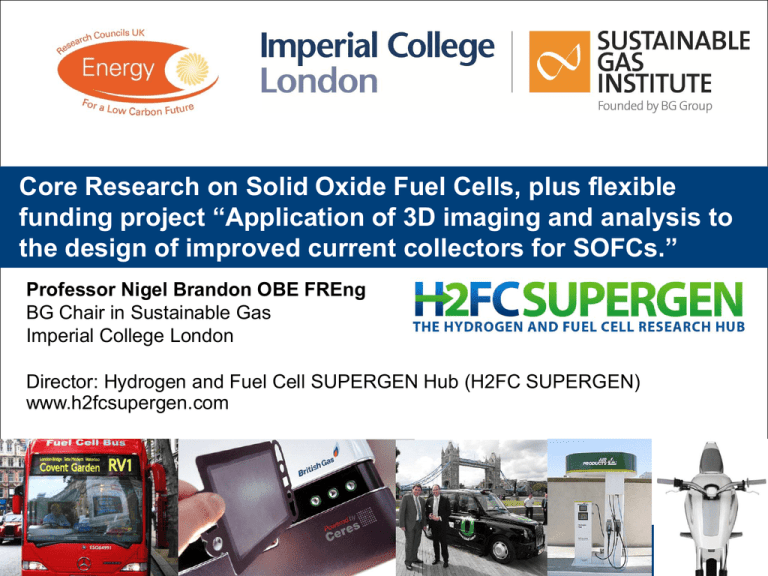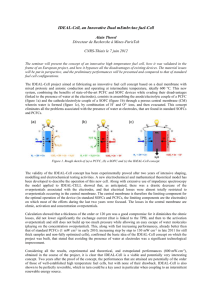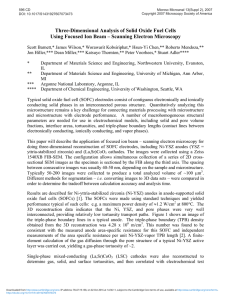Core Research on Solid Oxide Fuel Cells, plus flexible funding
advertisement

Core Research on Solid Oxide Fuel Cells, plus flexible funding project “Application of 3D imaging and analysis to the design of improved current collectors for SOFCs.” Professor Nigel Brandon OBE FREng BG Chair in Sustainable Gas Imperial College London Director: Hydrogen and Fuel Cell SUPERGEN Hub (H2FC SUPERGEN) www.h2fcsupergen.com www.imperial.ac.uk/energyfutureslab Content • Core - 3D Imaging and Analysis of Solid Oxide Fuel Cell Electrodes. • Flexible - Application of 3D imaging and analysis to the design of improved current collectors for SOFCs • Core - New approaches to SOFC electrode fabrication. • Summary. Ambition – to move to a move towards a design led approach to optimum SOFC electrodes Typical planar SOFC geometries Brett DJL, Atkinson A, Brandon NP, Skinner SJ, Intermediate temperature solid oxide fuel cells, CHEM SOC REV, 2008, Vol:37, Pages:1568-1578 SOFC Electrode Design Illustration of the effect of extending the TPB using a MIEC electrolyte. (a) Electrolyte / cermet anode with active TPB circled; (b) mechanism of reaction at the TPB; (c) mechanism of reaction at the extended TPB. Electrode Microstructure in three dimensions TPB 2 TPB 1 TPB 3 X-ray Microtomogaphy 100µm3 CT/Synchrotron Mechanical Sectioning 1µm3 Dual Beam FIB Tomo X-ray NCT Electron Tomo 10 nm3 Volume Size Analysis 10mm3 >1m3 Tomography techniques to resolve 3D microstructure 3D Atom Probe 0.1 nm 10 nm 1µm 100µm Combine multiple tomographic techniques Functional Materials Multi-scale Tomography FOV/Resolution We can apply this to SOFC/LIB electrodes And other materials ……… 1mm 1mm 1cm >1m Farid Tariq et al, Acta Materialia 59(5),2011 Page 6 Voxel Length Scale Diagram After Uchic and Holzer, MRS Bulletin, 2007 Tomography of Ni-ScSZ electrodes Ni 30 Vol.% A Ni 40 Vol.% Ni B Ni 50 Vol.% Ni C ScSZ ScSZ Pores Pores 5 µm 5 µm Pores 5 µm Ni Percolation Threshold • Allows feature extraction (Ni/ScSZ/Pores) • FIBSEM, voxel sizes ~20-50nm • 1350ºC sintering, 1 hr at temperature, reduced Ni Percolated Fabrication and characterization of Ni/ScSZ cermet anodes for IT-SOFCs, Somalu MR, Yufit V, Cumming D, Lorente E, Brandon NP, INTERNATIONAL JOURNAL OF HYDROGEN ENERGY, 2011, Vol:36, Pages:5557-5566. Percolated nickel networks Ni 30 Vol.% A Ni 40 Vol.% Considered Ni Percolation Threshold Ni 50 Vol.% Considered Ni Percolated Considered Ni Percolated Ni 5 µm B Ni 5 µm C 5 µm Preliminary results indicate: • Ni30 – 65% of Ni is percolated • Ni40 – 97% of Ni is percolated • Ni50 – 90% of nickel is percolated Surface Area of particles in total volume analysed (x 103 m-1) Ni 646 Ni 2481 Ni 1594 Pores 1317 Pores 2976 Pores 1999 ScSZ 1345 ScSZ 4195 ScSZ 2130 Advanced Analysis: 3D Interface Changes Ni30-Ni50 Ni 30 Vol.% Ni 50 Vol.% A B Ni Ni Pores ScSZ 8 µm Ni Percolation Threshold Ni Percolated • • • • • • Auriga Zeiss, 5kV, SEI, 1nA 100-200 Images Feature extraction (Ni/ScSZ/Pores) FIBSEM, voxel sizes ~20-30nm 1350ºC sintering, 2 hr at temperature Ni 30% has some particles forming percolated networks and other particles separate • Ni content >30% is very well connected Page 2 M.Samalu et al, Intl Journal of Hydrogen Energy 36(9),2011 Advanced Analysis of 3D Microstructure Changes A B C 5 µm D E 10 µm Example: Particles of Nickel Page 4 Necks between adjacent particles : Percolation, sintering and strain 3D imaging and quantification of interfaces in SOFC anodes, F. Tariq, M.Kishimoto, V.Yufit, G.Cui, M.Somalu and N.Brandon (Journal of European Ceramic Society, In Press & Available May 2014) 3D Interfaces: Structure-property-behaviour Experimental, Analytical and Modeling Results Ni-Ni 6 ScSZ-ScSZ 2 4 2 0 Expt Sim 1 1 0 0 Ratio Expt Sim Neck Ratio N/A Expt Sim Ratio Experimentally Measured and Modelled Ni30ScSZ Ni50ScSZ Ratio Ni-Ni necks (nm2/nm3) 2.7x10-4 3.55x10-4 1.32 Resistance:3.5 ScSZ-ScSZ necks (nm2/nm3) 4.86x10-4 3.22x10-4 1.5 Ni-ScSZ necks (nm2/nm3) 15.7x10-4 19.5x10-4 1.2 Page 15 Ni-ScSZ 2 Conductivity Change Expt. – 4 Sim. – 3.7 Most (though not all) load is passed through ceramic matrix Young's Modulus TPB Density For electrical conductivity any contact (e.g. more necks) would cause a larger expt. conductivity increase Expt. 1.4±0.1 Sim. - 1.1 Expt. - 1.1 Sim. – N/A 3D imaging and quantification of interfaces in SOFC anodes, F. Tariq, M.Kishimoto, V.Yufit, G.Cui, M.Somalu and N.Brandon (Journal of European Ceramic Society, In Press & Available May 2014) SOFC Tomography and Modelling Unanswered Questions Definition of Ni-YSZ Interface? Self-Contact? Fatigue/Cracking Behaviour? Schematic from P.J.Withers, Adv. Eng. Materials, 2011 Mechanisms at work LSCF Electrode Imaging and Modelling 700°C Porosity 2 µm LSCF Phases Advanced 3D Imaging and Analysis of SOFC Electrodes F.Tariq, M.Kishimoto, S.J Cooper, P.Shearing , N.P.Brandon, ECS Trans, 2013 Microstructural Analysis of an LSCF Cathode using in-situ tomography and simulation S.J Cooper, M.Kishimoto, F.Tariq, R.Bradley, A.Marquis, N.P.Brandon, J.Kilner, P.Shearing , ECS Trans, 2013 Flow Modelling in Porous structures (Pa) Higher pressure Low pressure Fluid Inlet 5 µm - Pressure gradient calculated across microstructure - This can be used to calculate permeability - A measure of how much fluid could pass through this type of structure Application of 3D imaging and analysis to the design of improved current collectors for SOFCs N Brandon, A Atkinson & Z Chen with Ceres Power The core of the Ceres proposition is its unique metal-supported cell AIR • Cathode Layer Stainless Steel Substrate Thin steel substrate with even thinner layers of active SOFC materials coated on top ELECTRICITY FUEL • Low temperature electrolyte (ceria) enables operation at <600 oC • Key advantages: Ceria Electrolyte Layer Anode Layer – Low cost cells – Compact, lightweight design – Mechanically tough – Simple & reliable stack sealing – Enables low cost balance of plant © Ceres Power 2013 Title: 8th International Smart Hydrogen and Fuel Cell Conference Rev: 1.0 10 Methodology Simulation Experiment Indentation experiment on bulk/films/cells Elastic properties Response curves Fracture criteria prediction with varied current collector designs 3D models with different material constitutives 3D models by FIB/SEM tomography Indentation FEM Compression FEM Response curves Elastic properties Electrode structure optimisation Electrolyte failure estimation As FEM input parameters Compare and validate the models Axisymmetric modelling of mechanical indentation into electrodes Indentation process in axisymmetric modelling (a) before indentation, (b) loading to a maximum depth, and (c) complete unloading generated residual depth. Nano-indentation curves for porous LSCF cathodes 300 500 900°C_Experime nt Load (mN) Load (mN) 400 1000°C_Experiment 1000°C_Simulation 250 300 200 100 200 150 100 50 0 0 0 800 1600 2400 3200 4000 Indentation depth (nm) 0 400 800 1200 1600 Indentation depth (nm) 2000 80 300 1100°C_Experim ent 250 1200°C_Experiment 1200°C_Simulation 70 200 Load (mN) Load (mN) 60 150 100 50 40 30 20 50 10 0 0 0 200 400 600 800 Indentation depth (nm) 1000 0 40 80 120 160 Indentation depth (nm) Comparison of load vs. depth curves for models with varying porosities resulted from different sintering temperatures. Porous LSCF sintered at different temps, 50 to 30 vol% porous, pellet, spherical indenter, 25 mm radius, RT data Results: elastic modulus and hardness Comparison of elastic modulus and hardness results determined by experiment and simulation Sintering temperature (°C) 900 1000 1100 1200 Method Experiment Simulation Experiment Simulation Experiment Simulation Experiment Simulation hmax (nm) 4008.4 1973.4 950.1 164.1 Pmax (mN) S (mN/nm) a (nm) 437.9 1.05 13079.4 409.5 1.13 13146.3 241.4 0.89 9221.2 246.4 0.93 9256.5 252.2 1.02 6136.2 258.2 1.04 6137.0 67.5 0.86 2294.7 68.2 0.78 2241.1 E (GPa) H (GPa) 34.1 36.1 47.2 47.2 75.9 71.6 189.3 173.9 0.83 0.75 0.90 0.91 2.19 2.18 4.03 4.17 Electrode fabrication: porous scaffold Tape casting or screen printing Porous CGO Pore former YSZ Slurry CGO Mixture of commercial powder and nano-powder (supplied by Prof Jawwad Darr, UCL) YSZ Co-sintering T > 1300 C State of the art electrodes: Impregnation of porous scaffolds Porous scaffold Metal nitrate solution Infiltration 550ºC, 1 h + heating & cooling n times Decomposition To oxide University of St Andrews University of Pennsylvania FIB-SEM: 1 x infiltration After reduction Before reduction CGO NiO Ni Enhanced triple phase boundary density in infiltrated electrodes for SOFCs, M Kishimoto, M Lomberg, E Ruiz-Trejo and N P Brandon, J Power Sources, 2014, Vol:266, Pages:291-295.. 3D reconstruction Ni x 1 -GDC GDC Ni Ni-GDC TPB TPB (with GDC) 4.2 μm Ni (with GDC) Enhanced triple phase boundary density in infiltrated electrodes for SOFCs, M Kishimoto, M Lomberg, E Ruiz-Trejo and N P Brandon, J Power Sources, 2014, Vol:266, Pages:291-295.. 3D reconstruction Ni(10)-GDC GDC Ni Ni-GDC TPB TPB (with GDC) 7.5 μm Ni (with GDC) Enhanced triple phase boundary density in infiltrated electrodes for SOFCs, M Kishimoto, M Lomberg, E Ruiz-Trejo and N P Brandon, J Power Sources, 2014, Vol:266, Pages:291-295.. Quantification Volume fraction [%] Particle/pore size [μm] TPB density [μm/μm3] GDC scaffold Ni(1)-GDC Ni(10)-GDC Conventional Ni-YSZ Ni GDC 0.00 57.1 1.29 56.9 19.8 60.2 25.3 25.1 Pore 42.9 41.8 20.1 49.6 Ni GDC Pore N/A 0.844 0.667 0.102 0.748 0.594 0.354 0.706 0.300 1.38 0.730 1.74 N/A 11.0 18.4 2.49 Enhanced triple phase boundary density in infiltrated electrodes for SOFCs, M Kishimoto, M Lomberg, E Ruiz-Trejo and N P Brandon, J Power Sources, 2014, Vol:266, Pages:291-295.. Electrolyte Supported Cell Fabrication and Testing (Air) (Fuel) 11mm 16mm Working Electrode (WE) Counter Electrode (CE) Reference Electrode (RE) 1mm 2M Ni(NO3)2 10-20μm 270μm 10-20μm Electrolyte 20mm • 20-80% H2 • 550-750˚C Screen Printed GDC, sintered at 1350˚C Commercial electrolyte, YSZ Screen Printed commercial LSCF-GDC Ni(NO3)2 decomposition at 500˚C M Lomberg, E Ruiz-Trejo, G Offer and N P Brandon, Characterization of Ni-Infiltrated 26GDC Electrodes for Solid Oxide Cell Applications, J Electrochem. Soc., 2014, accepted for publication Impedance Spectroscopy Results 10 times Ni-infiltrated GDC electrode, P(H2)=0.5atm, 100k-0.1Hz, OCV 580oC 690oC 750oC Fitting -Z'' (cm2) 0.15 L1 R_hfi 0.10 2.5kHz 0.05 Element 3.4kHz L1 0.00 R_hfi R_h CPE1-T CPE1-P 0.00R_l CPE2-T CPE2-P 0.05 M Lomberg, E Ruiz-Trejo, Oxide Cell Applications, J R_l CPE1 CPE2 0.6kHz Freedom Free(+) Free(+) Free(+) Free(+) Free(+) Free(+)0.10 Free(+) Free(+) Data File: Circuit Model File: R_h Value 1.9281E-07 1.271 0.24069 1.818 0.54251 0.092636 0.15 0.017949 2 0.59862 Z' (cm ) Error N/A N/A N/A N/A N/A N/A0.20 N/A N/A Error % N/A N/A N/A N/A N/A N/A N/A N/A C:\Users\ml2610\Dropbox\PhD\Sync folders from IC desk\3 On going\Experimental Da ta\Experimental 10xNi-CGO-YSZ-LSCF-CGO\2 G Offer and N P Brandon, Characterization of Ni-Infiltrated 4-01-2013\All data files\FRA data\high t Electrochem. Soc., 2014, accepted for publication emperature_2.mdl GDC Electrodes for Solid 27 Summary •Progress continues to be made in the application and interpretation of 3D imaging to understand SOFC electrodes structures, and how these relate to performance. •In the next 12 months we will be able to leverage new EPSRC capital investments in imaging and characterisation tools and additive manufacturing. • Our ultimate ambition is to move towards a design led approach to SOFC fabrication, and to develop in-silico accelerated ageing methodologies, in order to optimise both performance and lifetime of operating devices. Acknowledgements •3D imaging and analysis–Dr. Farid Tariq, Dr. Masashi Kishimoto, Dr Khalil Rhazoui, Prof Claire Adjiman, Dr Qiong Cai (Surrey), Guansen Cui, Sam Cooper, Dr. Paul Shearing (UCL), Prof. Peter Lee and Dr. Dave Eastwood (Manchester). •Scaffold electrodes– Dr Enrique Ruiz-Trejo, Dr Paul Boldrin, Marina Lomberg, Zadariana Jamil, Prof Jawwad Darr (UCL). •The EPSRC for funding. •Current collector Project collaborators Ceres Power.



